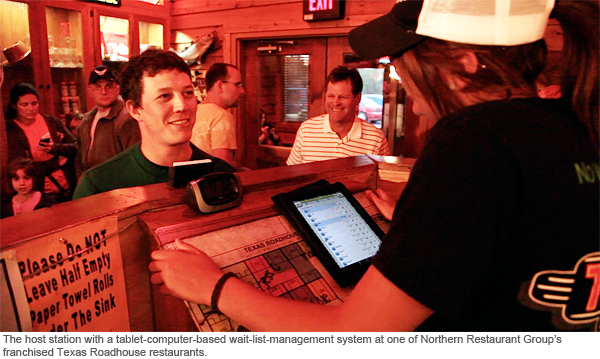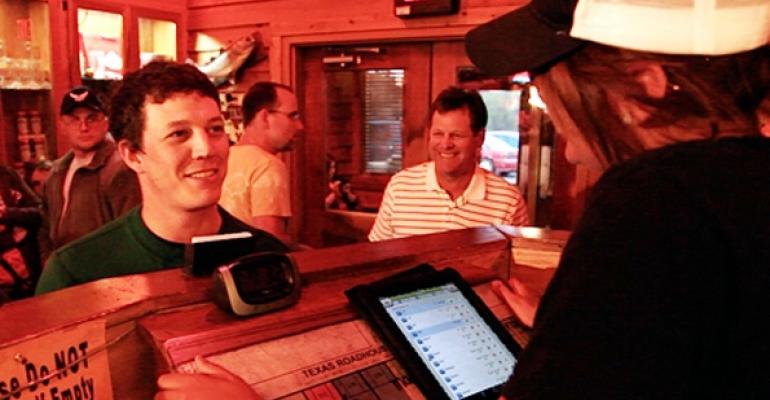Operators of restaurants with regular waits for tables say they are replacing paper, chalkboards and pagers with more efficient wait-list management software for tablet computers that, among other features, notifies guests of seating availability via text message.
Red Robin, Texas Roadhouse, Yard House and Umami Burger are among the restaurant chains with company or franchised units using this updated form of wait-list technology.
RELATED
• Restaurants divided on mobile payments platforms
• Study: Mobile traffic for menu searches accelerates
• More restaurant industry technology news
Employees enter guest names, party size and other information using the software and, depending on the program's features, organize the list and prioritize seating by the amount of time a party has been waiting, among other criteria. They also might generate estimated wait times or recap average wait times, note guest seating or service preferences, and track table inventory.
These features often translate to greater efficiencies, according to Todd Sapet, managing partner of Texas Roadhouse in Beaver, Pa. Northern Restaurant Group of Louisville, Ky., the operator of seven franchised Texas Roadhouse restaurants, including the one managed by Sapet, uses NoWait software hosted by NoWait Inc. at all of its locations.

“Literally, since we started using this [software and service], we’ve shaved our waits down to 25 minutes, on average, and rarely go over a 30-minute wait," Sapet said of NoWait, which employees have been using on iPads and iPhones since February. “Traditionally, our waits would be up to an hour, or hour and a half.”
Greenwood Village, Colo.-based Red Robin Gourmet Burgers Inc. has also seen improvements in operations with new wait-list management software. Last week, the company announced that it had rolled out NoshList software from Firespotter Labs to its 330-plus company-operated casual-dining restaurants. The software works on iPads and has text-message and auto-call guest notification capabilities.
Chris Laping, Red Robin’s senior vice president of business transformation, said in a written statement that beyond improving guest experience, the new software “increased seating efficiencies and improved ticket flow through the kitchen.” That combination, he indicated, reduced wait times for guests and improved ticket times for the chain.
Fourteen-unit Umami Burger of Los Angeles also uses NoshList on iPads at all of its locations, according to PJ Patton, general manager of the San Francisco location. She said her team finds useful a feature through which guests can text-message the restaurant back about how long it might take them to return if they are off site, or if they changed their mind about dining there — in which case staff is alerted by the program to remove the party from the wait list.
Calculating ROI
Since most new wait-list management software offers the ability to automatically send text messages or call cell phones to let guests know their table is ready, it helps to reduce dining room noise from PA systems. It also rids restaurants of the need for pagers, which can be easily stolen or lost, noted Phil Crawford, chief information officer of Yard House Restaurants.
He said the Irvine, Calif.-based company has a goal to roll out Freshtxt software from Heartland Payment Systems systemwide in 2013. The company has tested the software at two of its 40 Yard House restaurants.
“Strictly from a cost standpoint, it’s a huge return on investment not having to buy pagers that get stolen every single day," he said. "At $40 a pager, if we lose 100 a month, that’s not cheap."
According to Crawford, Yard House also benefits from the vendor-hosted software’s table-management functions, such as graphic depictions of tables with checks that should soon be available for other parties. The ability of employees using tablet computers or mobile devices to instantly update the system when a table has been bussed and is ready for seating is another positive, he said.
“If I can seat and turn an increased number of [diners] per week,” Crawford said, “there’s revenue generation going on.”
Also a plus, he said, is that the software enables employees using tablets or mobile devices to “line bust,” or enter guest information for the wait list from both sides of the hostess station to keep long queues from forming.
Some wait-list management systems also collect data to create analytical reports of operational metrics. Sapet at Texas Roadhouse, for example, said the NoWait software’s daily analytical reports gave his team the information it needed to reconfigure its dining room "to make our seating ratios more efficient,” he said. “Now I have six two tops, instead of three four tops [in one section] and those seats are always filled.”
Many, if not most, of the latest wait-list-management systems are offered as a hosted-software service for a standard monthly fee of from $49 to $199 per restaurant before volume discounts or additional charges for customized interfaces or features. Some providers of the technology offer a free basic service on an ongoing or trial basis.
Contact Alan J. Liddle at [email protected].
Follow him on Twitter: @AJ_NRN

